SNPG917: Breastfeeding and Infant Health: Evidence-Based Report
VerifiedAdded on 2023/01/04
|11
|3186
|67
Report
AI Summary
This report examines the critical role of breastfeeding in ensuring the healthy growth and development of infants, with a focus on evidence-based practices. It begins by highlighting the importance of exclusive breastfeeding for the first six months, emphasizing its positive impact on infant health, immunity, and reduced mortality rates. The research question explores the advantages of breastfeeding, the issues associated with its lack, and its role in lowering global mortality rates, followed by a comprehensive search summary. The report provides a summary of evidence, including key terms, critical review, and synthesis of findings from various studies and organizations like WHO and UNICEF, highlighting the nutritional benefits, protective effects against diseases, and the impact on infant mortality rates. Professional steps taken to educate parents are also discussed. The synthesis section underscores the global recognition of breastfeeding, its positive effects on child development, and the importance of initiatives by health organizations. The report concludes by emphasizing the benefits of breastfeeding for infants, which include perfect nourishment, supply of complete nutrition, and protection against various viruses and diseases, while also stressing the role of professional campaigns in educating mothers about breastfeeding and its importance in infant growth and development.
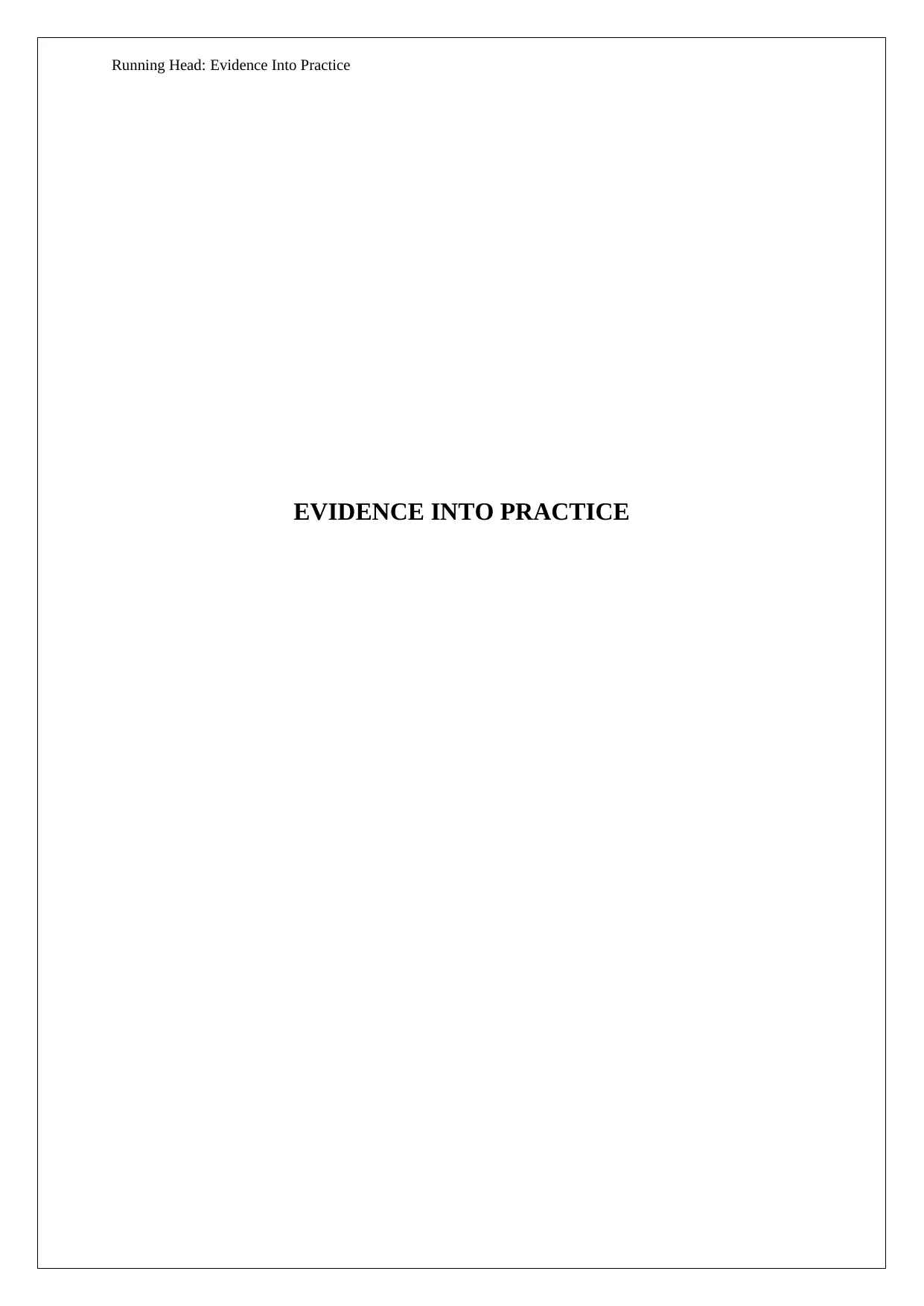
Running Head: Evidence Into Practice
EVIDENCE INTO PRACTICE
EVIDENCE INTO PRACTICE
Paraphrase This Document
Need a fresh take? Get an instant paraphrase of this document with our AI Paraphraser
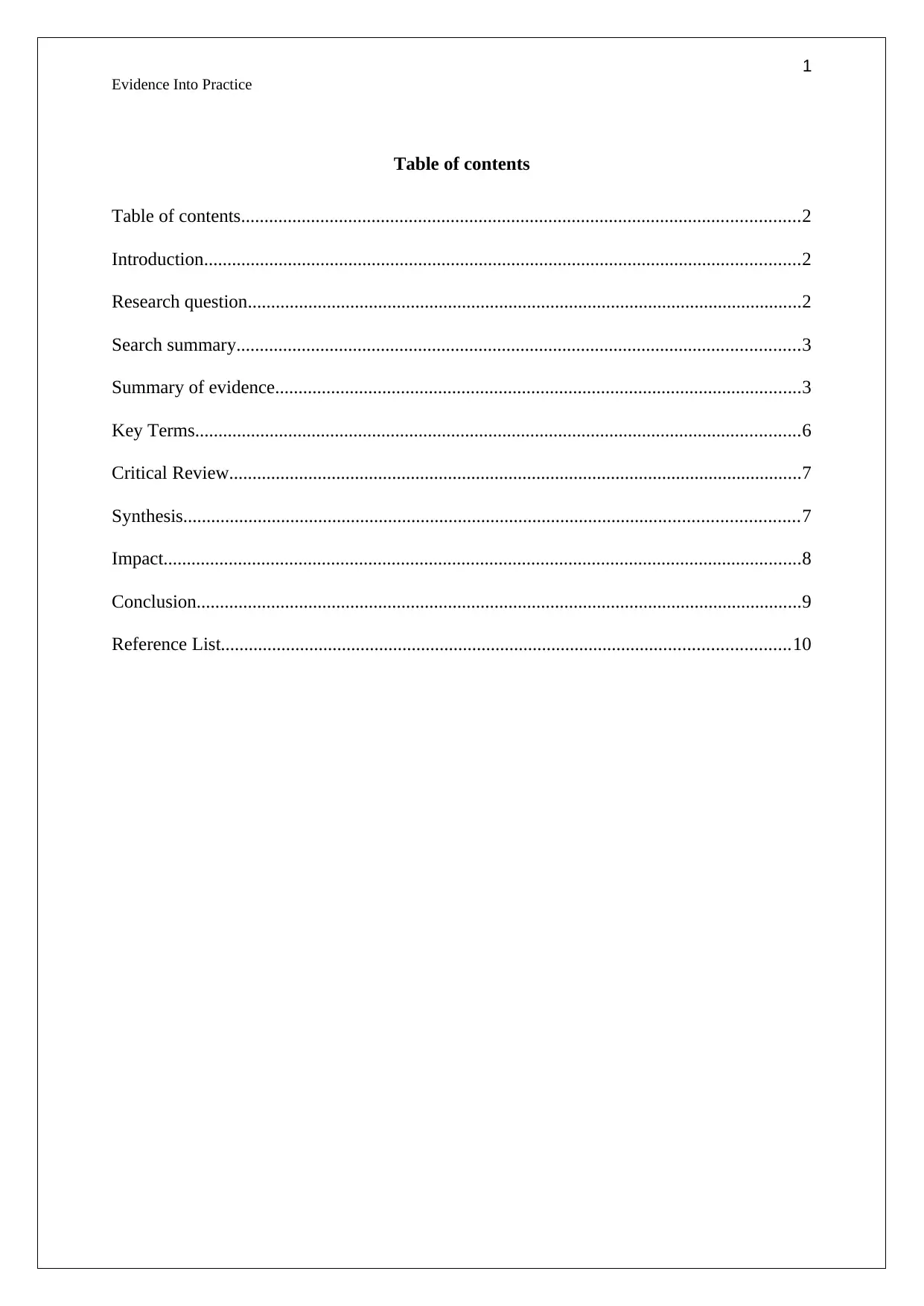
1
Evidence Into Practice
Table of contents
Table of contents........................................................................................................................2
Introduction................................................................................................................................2
Research question.......................................................................................................................2
Search summary.........................................................................................................................3
Summary of evidence.................................................................................................................3
Key Terms..................................................................................................................................6
Critical Review...........................................................................................................................7
Synthesis....................................................................................................................................7
Impact.........................................................................................................................................8
Conclusion..................................................................................................................................9
Reference List..........................................................................................................................10
Evidence Into Practice
Table of contents
Table of contents........................................................................................................................2
Introduction................................................................................................................................2
Research question.......................................................................................................................2
Search summary.........................................................................................................................3
Summary of evidence.................................................................................................................3
Key Terms..................................................................................................................................6
Critical Review...........................................................................................................................7
Synthesis....................................................................................................................................7
Impact.........................................................................................................................................8
Conclusion..................................................................................................................................9
Reference List..........................................................................................................................10
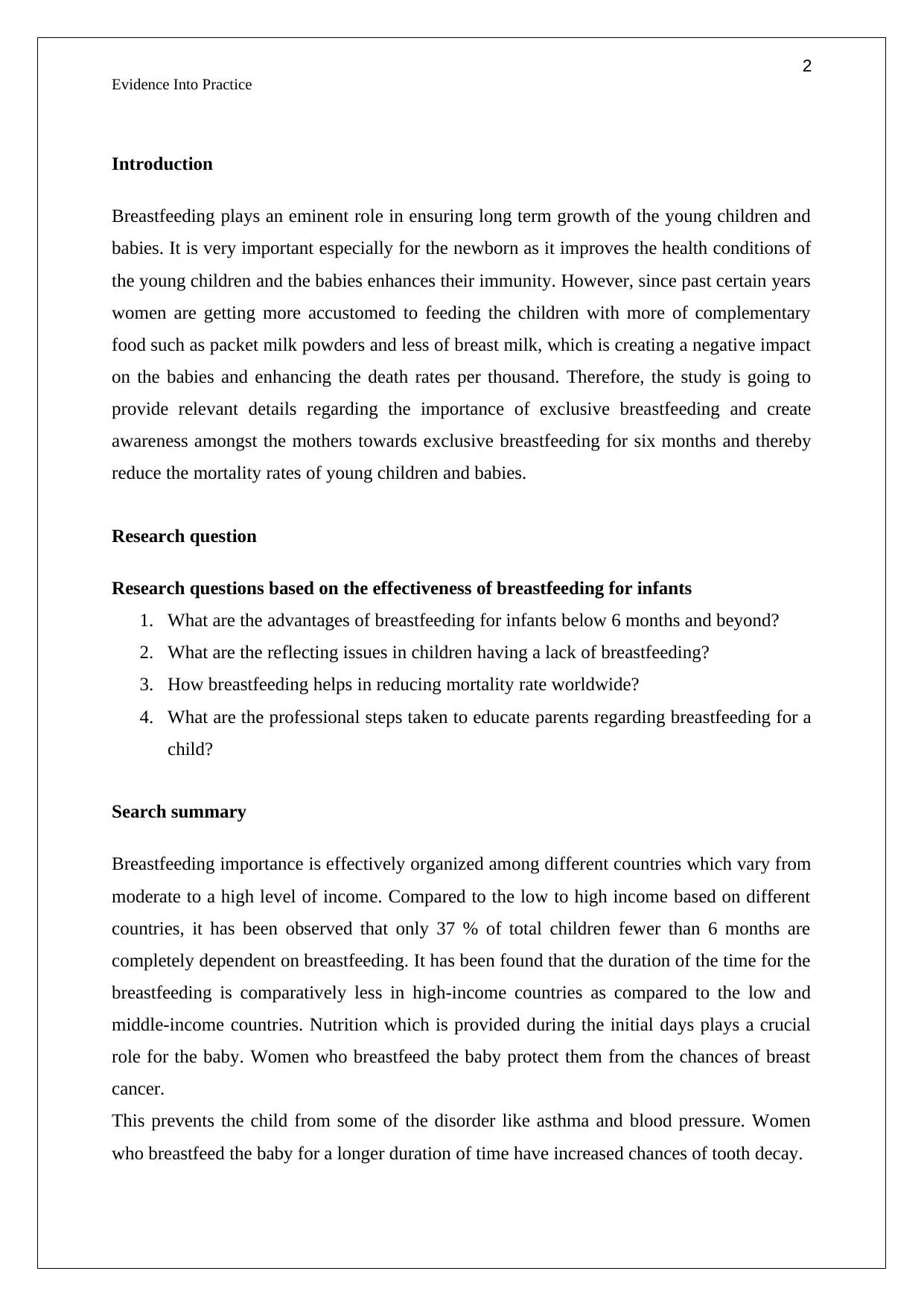
2
Evidence Into Practice
Introduction
Breastfeeding plays an eminent role in ensuring long term growth of the young children and
babies. It is very important especially for the newborn as it improves the health conditions of
the young children and the babies enhances their immunity. However, since past certain years
women are getting more accustomed to feeding the children with more of complementary
food such as packet milk powders and less of breast milk, which is creating a negative impact
on the babies and enhancing the death rates per thousand. Therefore, the study is going to
provide relevant details regarding the importance of exclusive breastfeeding and create
awareness amongst the mothers towards exclusive breastfeeding for six months and thereby
reduce the mortality rates of young children and babies.
Research question
Research questions based on the effectiveness of breastfeeding for infants
1. What are the advantages of breastfeeding for infants below 6 months and beyond?
2. What are the reflecting issues in children having a lack of breastfeeding?
3. How breastfeeding helps in reducing mortality rate worldwide?
4. What are the professional steps taken to educate parents regarding breastfeeding for a
child?
Search summary
Breastfeeding importance is effectively organized among different countries which vary from
moderate to a high level of income. Compared to the low to high income based on different
countries, it has been observed that only 37 % of total children fewer than 6 months are
completely dependent on breastfeeding. It has been found that the duration of the time for the
breastfeeding is comparatively less in high-income countries as compared to the low and
middle-income countries. Nutrition which is provided during the initial days plays a crucial
role for the baby. Women who breastfeed the baby protect them from the chances of breast
cancer.
This prevents the child from some of the disorder like asthma and blood pressure. Women
who breastfeed the baby for a longer duration of time have increased chances of tooth decay.
Evidence Into Practice
Introduction
Breastfeeding plays an eminent role in ensuring long term growth of the young children and
babies. It is very important especially for the newborn as it improves the health conditions of
the young children and the babies enhances their immunity. However, since past certain years
women are getting more accustomed to feeding the children with more of complementary
food such as packet milk powders and less of breast milk, which is creating a negative impact
on the babies and enhancing the death rates per thousand. Therefore, the study is going to
provide relevant details regarding the importance of exclusive breastfeeding and create
awareness amongst the mothers towards exclusive breastfeeding for six months and thereby
reduce the mortality rates of young children and babies.
Research question
Research questions based on the effectiveness of breastfeeding for infants
1. What are the advantages of breastfeeding for infants below 6 months and beyond?
2. What are the reflecting issues in children having a lack of breastfeeding?
3. How breastfeeding helps in reducing mortality rate worldwide?
4. What are the professional steps taken to educate parents regarding breastfeeding for a
child?
Search summary
Breastfeeding importance is effectively organized among different countries which vary from
moderate to a high level of income. Compared to the low to high income based on different
countries, it has been observed that only 37 % of total children fewer than 6 months are
completely dependent on breastfeeding. It has been found that the duration of the time for the
breastfeeding is comparatively less in high-income countries as compared to the low and
middle-income countries. Nutrition which is provided during the initial days plays a crucial
role for the baby. Women who breastfeed the baby protect them from the chances of breast
cancer.
This prevents the child from some of the disorder like asthma and blood pressure. Women
who breastfeed the baby for a longer duration of time have increased chances of tooth decay.
⊘ This is a preview!⊘
Do you want full access?
Subscribe today to unlock all pages.

Trusted by 1+ million students worldwide
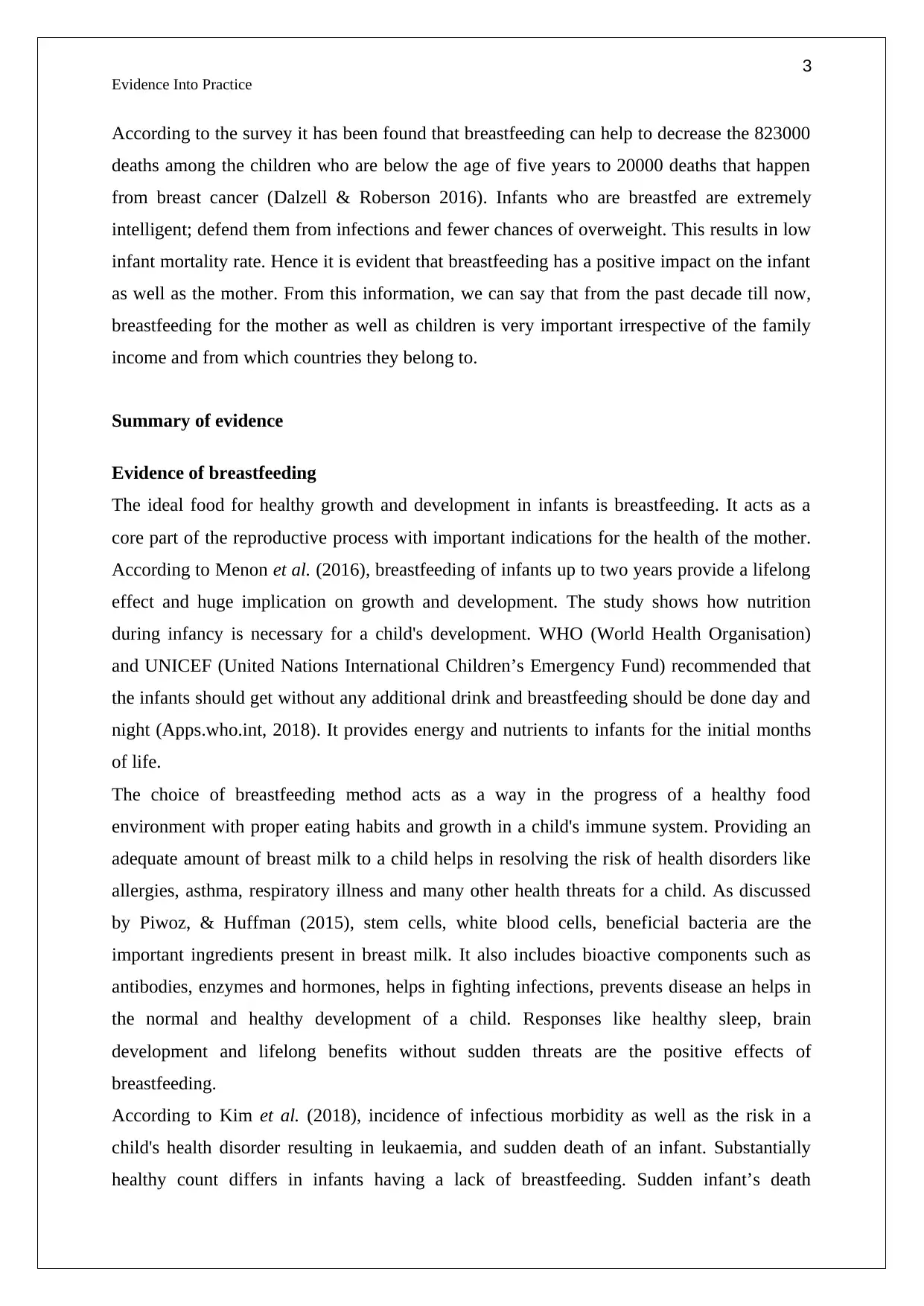
3
Evidence Into Practice
According to the survey it has been found that breastfeeding can help to decrease the 823000
deaths among the children who are below the age of five years to 20000 deaths that happen
from breast cancer (Dalzell & Roberson 2016). Infants who are breastfed are extremely
intelligent; defend them from infections and fewer chances of overweight. This results in low
infant mortality rate. Hence it is evident that breastfeeding has a positive impact on the infant
as well as the mother. From this information, we can say that from the past decade till now,
breastfeeding for the mother as well as children is very important irrespective of the family
income and from which countries they belong to.
Summary of evidence
Evidence of breastfeeding
The ideal food for healthy growth and development in infants is breastfeeding. It acts as a
core part of the reproductive process with important indications for the health of the mother.
According to Menon et al. (2016), breastfeeding of infants up to two years provide a lifelong
effect and huge implication on growth and development. The study shows how nutrition
during infancy is necessary for a child's development. WHO (World Health Organisation)
and UNICEF (United Nations International Children’s Emergency Fund) recommended that
the infants should get without any additional drink and breastfeeding should be done day and
night (Apps.who.int, 2018). It provides energy and nutrients to infants for the initial months
of life.
The choice of breastfeeding method acts as a way in the progress of a healthy food
environment with proper eating habits and growth in a child's immune system. Providing an
adequate amount of breast milk to a child helps in resolving the risk of health disorders like
allergies, asthma, respiratory illness and many other health threats for a child. As discussed
by Piwoz, & Huffman (2015), stem cells, white blood cells, beneficial bacteria are the
important ingredients present in breast milk. It also includes bioactive components such as
antibodies, enzymes and hormones, helps in fighting infections, prevents disease an helps in
the normal and healthy development of a child. Responses like healthy sleep, brain
development and lifelong benefits without sudden threats are the positive effects of
breastfeeding.
According to Kim et al. (2018), incidence of infectious morbidity as well as the risk in a
child's health disorder resulting in leukaemia, and sudden death of an infant. Substantially
healthy count differs in infants having a lack of breastfeeding. Sudden infant’s death
Evidence Into Practice
According to the survey it has been found that breastfeeding can help to decrease the 823000
deaths among the children who are below the age of five years to 20000 deaths that happen
from breast cancer (Dalzell & Roberson 2016). Infants who are breastfed are extremely
intelligent; defend them from infections and fewer chances of overweight. This results in low
infant mortality rate. Hence it is evident that breastfeeding has a positive impact on the infant
as well as the mother. From this information, we can say that from the past decade till now,
breastfeeding for the mother as well as children is very important irrespective of the family
income and from which countries they belong to.
Summary of evidence
Evidence of breastfeeding
The ideal food for healthy growth and development in infants is breastfeeding. It acts as a
core part of the reproductive process with important indications for the health of the mother.
According to Menon et al. (2016), breastfeeding of infants up to two years provide a lifelong
effect and huge implication on growth and development. The study shows how nutrition
during infancy is necessary for a child's development. WHO (World Health Organisation)
and UNICEF (United Nations International Children’s Emergency Fund) recommended that
the infants should get without any additional drink and breastfeeding should be done day and
night (Apps.who.int, 2018). It provides energy and nutrients to infants for the initial months
of life.
The choice of breastfeeding method acts as a way in the progress of a healthy food
environment with proper eating habits and growth in a child's immune system. Providing an
adequate amount of breast milk to a child helps in resolving the risk of health disorders like
allergies, asthma, respiratory illness and many other health threats for a child. As discussed
by Piwoz, & Huffman (2015), stem cells, white blood cells, beneficial bacteria are the
important ingredients present in breast milk. It also includes bioactive components such as
antibodies, enzymes and hormones, helps in fighting infections, prevents disease an helps in
the normal and healthy development of a child. Responses like healthy sleep, brain
development and lifelong benefits without sudden threats are the positive effects of
breastfeeding.
According to Kim et al. (2018), incidence of infectious morbidity as well as the risk in a
child's health disorder resulting in leukaemia, and sudden death of an infant. Substantially
healthy count differs in infants having a lack of breastfeeding. Sudden infant’s death
Paraphrase This Document
Need a fresh take? Get an instant paraphrase of this document with our AI Paraphraser
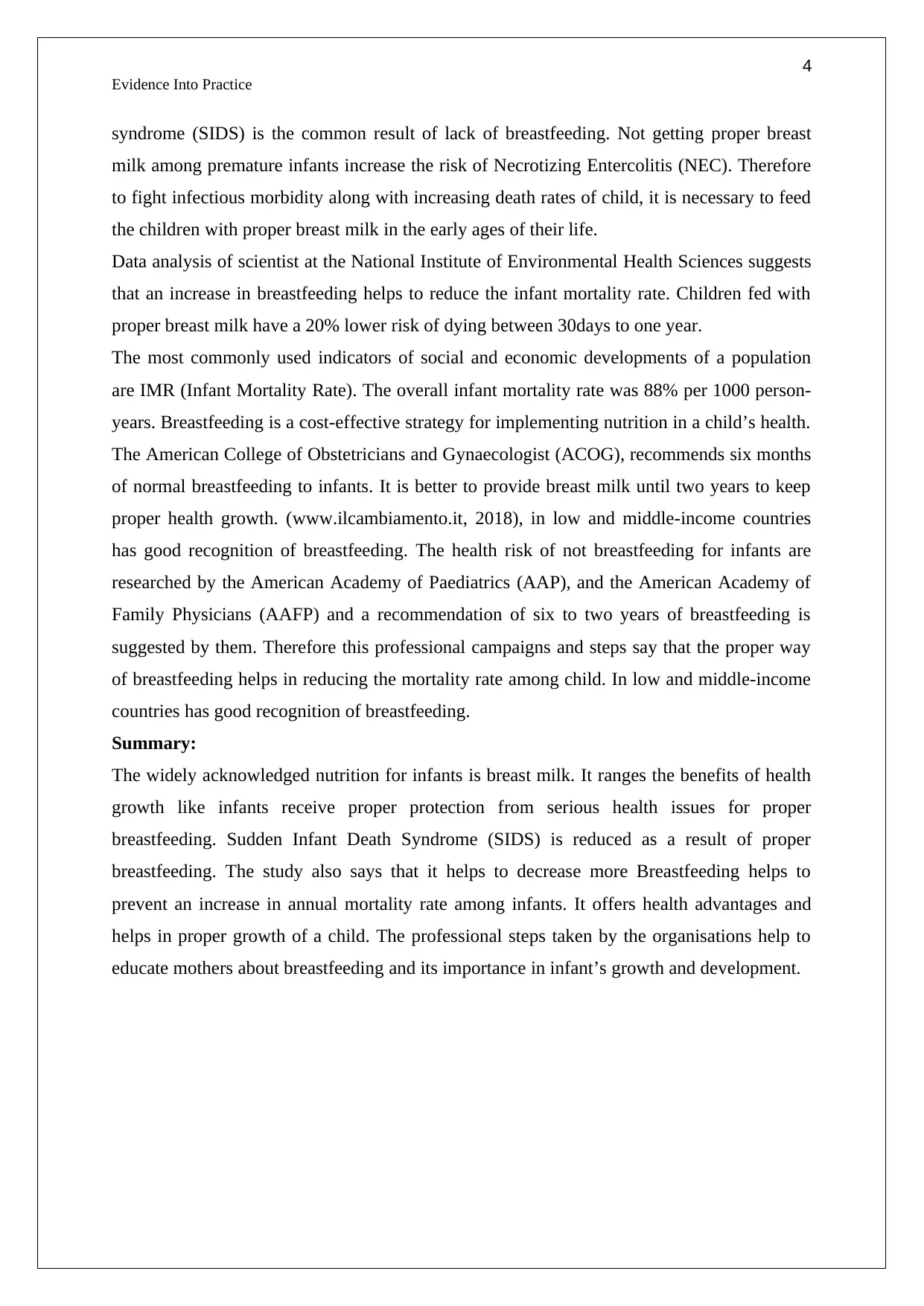
4
Evidence Into Practice
syndrome (SIDS) is the common result of lack of breastfeeding. Not getting proper breast
milk among premature infants increase the risk of Necrotizing Entercolitis (NEC). Therefore
to fight infectious morbidity along with increasing death rates of child, it is necessary to feed
the children with proper breast milk in the early ages of their life.
Data analysis of scientist at the National Institute of Environmental Health Sciences suggests
that an increase in breastfeeding helps to reduce the infant mortality rate. Children fed with
proper breast milk have a 20% lower risk of dying between 30days to one year.
The most commonly used indicators of social and economic developments of a population
are IMR (Infant Mortality Rate). The overall infant mortality rate was 88% per 1000 person-
years. Breastfeeding is a cost-effective strategy for implementing nutrition in a child’s health.
The American College of Obstetricians and Gynaecologist (ACOG), recommends six months
of normal breastfeeding to infants. It is better to provide breast milk until two years to keep
proper health growth. (www.ilcambiamento.it, 2018), in low and middle-income countries
has good recognition of breastfeeding. The health risk of not breastfeeding for infants are
researched by the American Academy of Paediatrics (AAP), and the American Academy of
Family Physicians (AAFP) and a recommendation of six to two years of breastfeeding is
suggested by them. Therefore this professional campaigns and steps say that the proper way
of breastfeeding helps in reducing the mortality rate among child. In low and middle-income
countries has good recognition of breastfeeding.
Summary:
The widely acknowledged nutrition for infants is breast milk. It ranges the benefits of health
growth like infants receive proper protection from serious health issues for proper
breastfeeding. Sudden Infant Death Syndrome (SIDS) is reduced as a result of proper
breastfeeding. The study also says that it helps to decrease more Breastfeeding helps to
prevent an increase in annual mortality rate among infants. It offers health advantages and
helps in proper growth of a child. The professional steps taken by the organisations help to
educate mothers about breastfeeding and its importance in infant’s growth and development.
Evidence Into Practice
syndrome (SIDS) is the common result of lack of breastfeeding. Not getting proper breast
milk among premature infants increase the risk of Necrotizing Entercolitis (NEC). Therefore
to fight infectious morbidity along with increasing death rates of child, it is necessary to feed
the children with proper breast milk in the early ages of their life.
Data analysis of scientist at the National Institute of Environmental Health Sciences suggests
that an increase in breastfeeding helps to reduce the infant mortality rate. Children fed with
proper breast milk have a 20% lower risk of dying between 30days to one year.
The most commonly used indicators of social and economic developments of a population
are IMR (Infant Mortality Rate). The overall infant mortality rate was 88% per 1000 person-
years. Breastfeeding is a cost-effective strategy for implementing nutrition in a child’s health.
The American College of Obstetricians and Gynaecologist (ACOG), recommends six months
of normal breastfeeding to infants. It is better to provide breast milk until two years to keep
proper health growth. (www.ilcambiamento.it, 2018), in low and middle-income countries
has good recognition of breastfeeding. The health risk of not breastfeeding for infants are
researched by the American Academy of Paediatrics (AAP), and the American Academy of
Family Physicians (AAFP) and a recommendation of six to two years of breastfeeding is
suggested by them. Therefore this professional campaigns and steps say that the proper way
of breastfeeding helps in reducing the mortality rate among child. In low and middle-income
countries has good recognition of breastfeeding.
Summary:
The widely acknowledged nutrition for infants is breast milk. It ranges the benefits of health
growth like infants receive proper protection from serious health issues for proper
breastfeeding. Sudden Infant Death Syndrome (SIDS) is reduced as a result of proper
breastfeeding. The study also says that it helps to decrease more Breastfeeding helps to
prevent an increase in annual mortality rate among infants. It offers health advantages and
helps in proper growth of a child. The professional steps taken by the organisations help to
educate mothers about breastfeeding and its importance in infant’s growth and development.
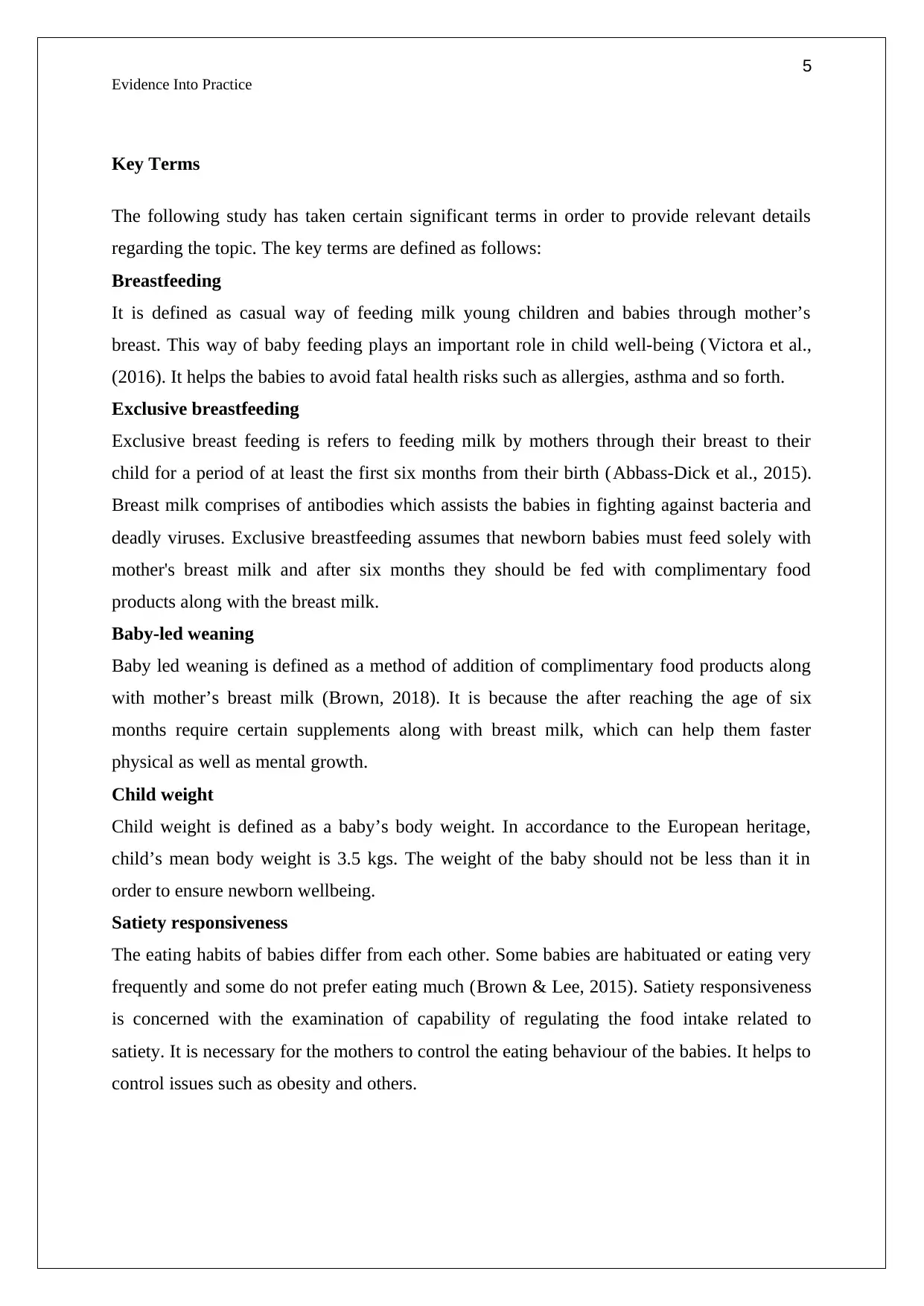
5
Evidence Into Practice
Key Terms
The following study has taken certain significant terms in order to provide relevant details
regarding the topic. The key terms are defined as follows:
Breastfeeding
It is defined as casual way of feeding milk young children and babies through mother’s
breast. This way of baby feeding plays an important role in child well-being (Victora et al.,
(2016). It helps the babies to avoid fatal health risks such as allergies, asthma and so forth.
Exclusive breastfeeding
Exclusive breast feeding is refers to feeding milk by mothers through their breast to their
child for a period of at least the first six months from their birth (Abbass-Dick et al., 2015).
Breast milk comprises of antibodies which assists the babies in fighting against bacteria and
deadly viruses. Exclusive breastfeeding assumes that newborn babies must feed solely with
mother's breast milk and after six months they should be fed with complimentary food
products along with the breast milk.
Baby-led weaning
Baby led weaning is defined as a method of addition of complimentary food products along
with mother’s breast milk (Brown, 2018). It is because the after reaching the age of six
months require certain supplements along with breast milk, which can help them faster
physical as well as mental growth.
Child weight
Child weight is defined as a baby’s body weight. In accordance to the European heritage,
child’s mean body weight is 3.5 kgs. The weight of the baby should not be less than it in
order to ensure newborn wellbeing.
Satiety responsiveness
The eating habits of babies differ from each other. Some babies are habituated or eating very
frequently and some do not prefer eating much (Brown & Lee, 2015). Satiety responsiveness
is concerned with the examination of capability of regulating the food intake related to
satiety. It is necessary for the mothers to control the eating behaviour of the babies. It helps to
control issues such as obesity and others.
Evidence Into Practice
Key Terms
The following study has taken certain significant terms in order to provide relevant details
regarding the topic. The key terms are defined as follows:
Breastfeeding
It is defined as casual way of feeding milk young children and babies through mother’s
breast. This way of baby feeding plays an important role in child well-being (Victora et al.,
(2016). It helps the babies to avoid fatal health risks such as allergies, asthma and so forth.
Exclusive breastfeeding
Exclusive breast feeding is refers to feeding milk by mothers through their breast to their
child for a period of at least the first six months from their birth (Abbass-Dick et al., 2015).
Breast milk comprises of antibodies which assists the babies in fighting against bacteria and
deadly viruses. Exclusive breastfeeding assumes that newborn babies must feed solely with
mother's breast milk and after six months they should be fed with complimentary food
products along with the breast milk.
Baby-led weaning
Baby led weaning is defined as a method of addition of complimentary food products along
with mother’s breast milk (Brown, 2018). It is because the after reaching the age of six
months require certain supplements along with breast milk, which can help them faster
physical as well as mental growth.
Child weight
Child weight is defined as a baby’s body weight. In accordance to the European heritage,
child’s mean body weight is 3.5 kgs. The weight of the baby should not be less than it in
order to ensure newborn wellbeing.
Satiety responsiveness
The eating habits of babies differ from each other. Some babies are habituated or eating very
frequently and some do not prefer eating much (Brown & Lee, 2015). Satiety responsiveness
is concerned with the examination of capability of regulating the food intake related to
satiety. It is necessary for the mothers to control the eating behaviour of the babies. It helps to
control issues such as obesity and others.
⊘ This is a preview!⊘
Do you want full access?
Subscribe today to unlock all pages.

Trusted by 1+ million students worldwide
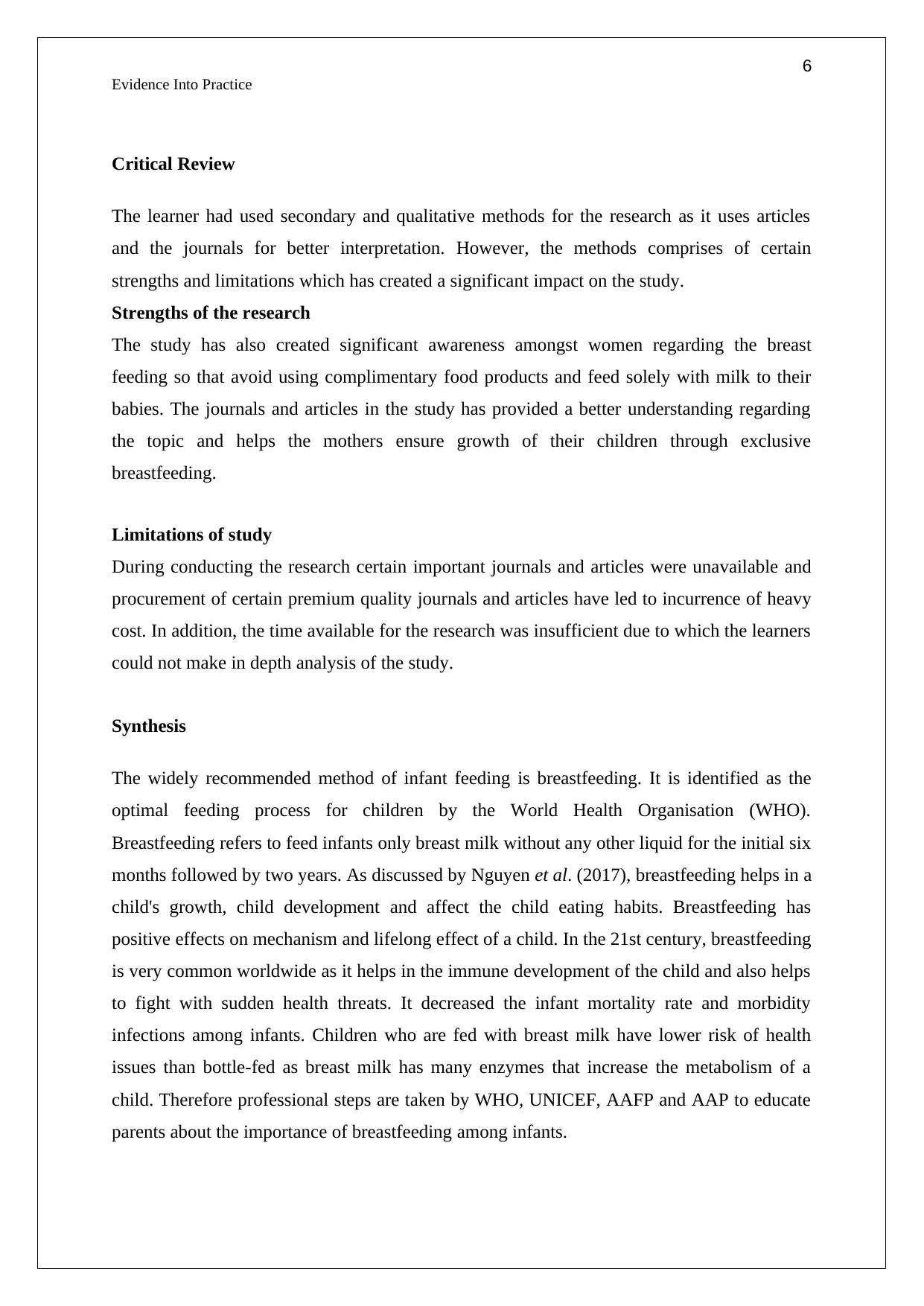
6
Evidence Into Practice
Critical Review
The learner had used secondary and qualitative methods for the research as it uses articles
and the journals for better interpretation. However, the methods comprises of certain
strengths and limitations which has created a significant impact on the study.
Strengths of the research
The study has also created significant awareness amongst women regarding the breast
feeding so that avoid using complimentary food products and feed solely with milk to their
babies. The journals and articles in the study has provided a better understanding regarding
the topic and helps the mothers ensure growth of their children through exclusive
breastfeeding.
Limitations of study
During conducting the research certain important journals and articles were unavailable and
procurement of certain premium quality journals and articles have led to incurrence of heavy
cost. In addition, the time available for the research was insufficient due to which the learners
could not make in depth analysis of the study.
Synthesis
The widely recommended method of infant feeding is breastfeeding. It is identified as the
optimal feeding process for children by the World Health Organisation (WHO).
Breastfeeding refers to feed infants only breast milk without any other liquid for the initial six
months followed by two years. As discussed by Nguyen et al. (2017), breastfeeding helps in a
child's growth, child development and affect the child eating habits. Breastfeeding has
positive effects on mechanism and lifelong effect of a child. In the 21st century, breastfeeding
is very common worldwide as it helps in the immune development of the child and also helps
to fight with sudden health threats. It decreased the infant mortality rate and morbidity
infections among infants. Children who are fed with breast milk have lower risk of health
issues than bottle-fed as breast milk has many enzymes that increase the metabolism of a
child. Therefore professional steps are taken by WHO, UNICEF, AAFP and AAP to educate
parents about the importance of breastfeeding among infants.
Evidence Into Practice
Critical Review
The learner had used secondary and qualitative methods for the research as it uses articles
and the journals for better interpretation. However, the methods comprises of certain
strengths and limitations which has created a significant impact on the study.
Strengths of the research
The study has also created significant awareness amongst women regarding the breast
feeding so that avoid using complimentary food products and feed solely with milk to their
babies. The journals and articles in the study has provided a better understanding regarding
the topic and helps the mothers ensure growth of their children through exclusive
breastfeeding.
Limitations of study
During conducting the research certain important journals and articles were unavailable and
procurement of certain premium quality journals and articles have led to incurrence of heavy
cost. In addition, the time available for the research was insufficient due to which the learners
could not make in depth analysis of the study.
Synthesis
The widely recommended method of infant feeding is breastfeeding. It is identified as the
optimal feeding process for children by the World Health Organisation (WHO).
Breastfeeding refers to feed infants only breast milk without any other liquid for the initial six
months followed by two years. As discussed by Nguyen et al. (2017), breastfeeding helps in a
child's growth, child development and affect the child eating habits. Breastfeeding has
positive effects on mechanism and lifelong effect of a child. In the 21st century, breastfeeding
is very common worldwide as it helps in the immune development of the child and also helps
to fight with sudden health threats. It decreased the infant mortality rate and morbidity
infections among infants. Children who are fed with breast milk have lower risk of health
issues than bottle-fed as breast milk has many enzymes that increase the metabolism of a
child. Therefore professional steps are taken by WHO, UNICEF, AAFP and AAP to educate
parents about the importance of breastfeeding among infants.
Paraphrase This Document
Need a fresh take? Get an instant paraphrase of this document with our AI Paraphraser
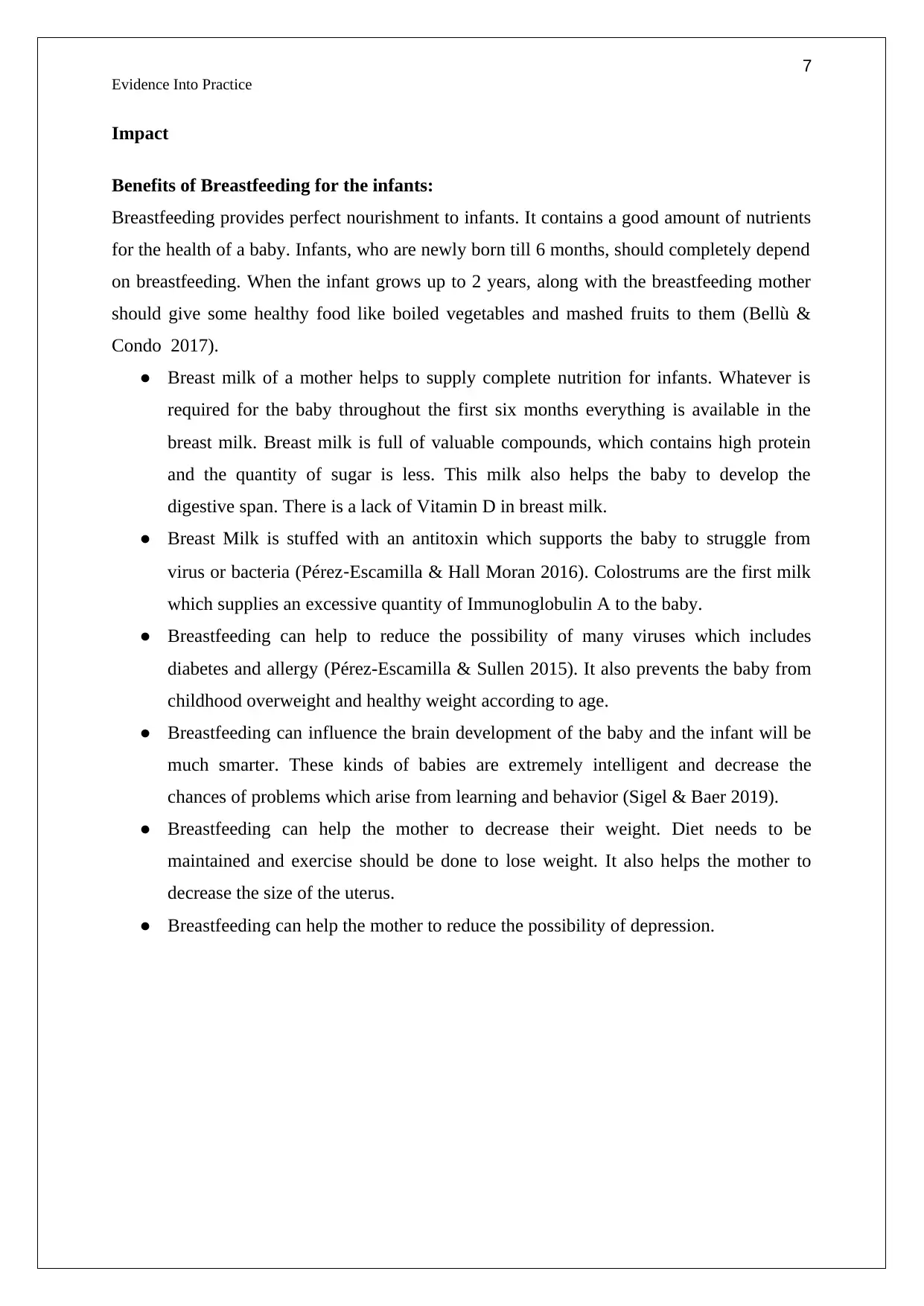
7
Evidence Into Practice
Impact
Benefits of Breastfeeding for the infants:
Breastfeeding provides perfect nourishment to infants. It contains a good amount of nutrients
for the health of a baby. Infants, who are newly born till 6 months, should completely depend
on breastfeeding. When the infant grows up to 2 years, along with the breastfeeding mother
should give some healthy food like boiled vegetables and mashed fruits to them (Bellù &
Condo 2017).
● Breast milk of a mother helps to supply complete nutrition for infants. Whatever is
required for the baby throughout the first six months everything is available in the
breast milk. Breast milk is full of valuable compounds, which contains high protein
and the quantity of sugar is less. This milk also helps the baby to develop the
digestive span. There is a lack of Vitamin D in breast milk.
● Breast Milk is stuffed with an antitoxin which supports the baby to struggle from
virus or bacteria (Pérez‐Escamilla & Hall Moran 2016). Colostrums are the first milk
which supplies an excessive quantity of Immunoglobulin A to the baby.
● Breastfeeding can help to reduce the possibility of many viruses which includes
diabetes and allergy (Pérez-Escamilla & Sullen 2015). It also prevents the baby from
childhood overweight and healthy weight according to age.
● Breastfeeding can influence the brain development of the baby and the infant will be
much smarter. These kinds of babies are extremely intelligent and decrease the
chances of problems which arise from learning and behavior (Sigel & Baer 2019).
● Breastfeeding can help the mother to decrease their weight. Diet needs to be
maintained and exercise should be done to lose weight. It also helps the mother to
decrease the size of the uterus.
● Breastfeeding can help the mother to reduce the possibility of depression.
Evidence Into Practice
Impact
Benefits of Breastfeeding for the infants:
Breastfeeding provides perfect nourishment to infants. It contains a good amount of nutrients
for the health of a baby. Infants, who are newly born till 6 months, should completely depend
on breastfeeding. When the infant grows up to 2 years, along with the breastfeeding mother
should give some healthy food like boiled vegetables and mashed fruits to them (Bellù &
Condo 2017).
● Breast milk of a mother helps to supply complete nutrition for infants. Whatever is
required for the baby throughout the first six months everything is available in the
breast milk. Breast milk is full of valuable compounds, which contains high protein
and the quantity of sugar is less. This milk also helps the baby to develop the
digestive span. There is a lack of Vitamin D in breast milk.
● Breast Milk is stuffed with an antitoxin which supports the baby to struggle from
virus or bacteria (Pérez‐Escamilla & Hall Moran 2016). Colostrums are the first milk
which supplies an excessive quantity of Immunoglobulin A to the baby.
● Breastfeeding can help to reduce the possibility of many viruses which includes
diabetes and allergy (Pérez-Escamilla & Sullen 2015). It also prevents the baby from
childhood overweight and healthy weight according to age.
● Breastfeeding can influence the brain development of the baby and the infant will be
much smarter. These kinds of babies are extremely intelligent and decrease the
chances of problems which arise from learning and behavior (Sigel & Baer 2019).
● Breastfeeding can help the mother to decrease their weight. Diet needs to be
maintained and exercise should be done to lose weight. It also helps the mother to
decrease the size of the uterus.
● Breastfeeding can help the mother to reduce the possibility of depression.
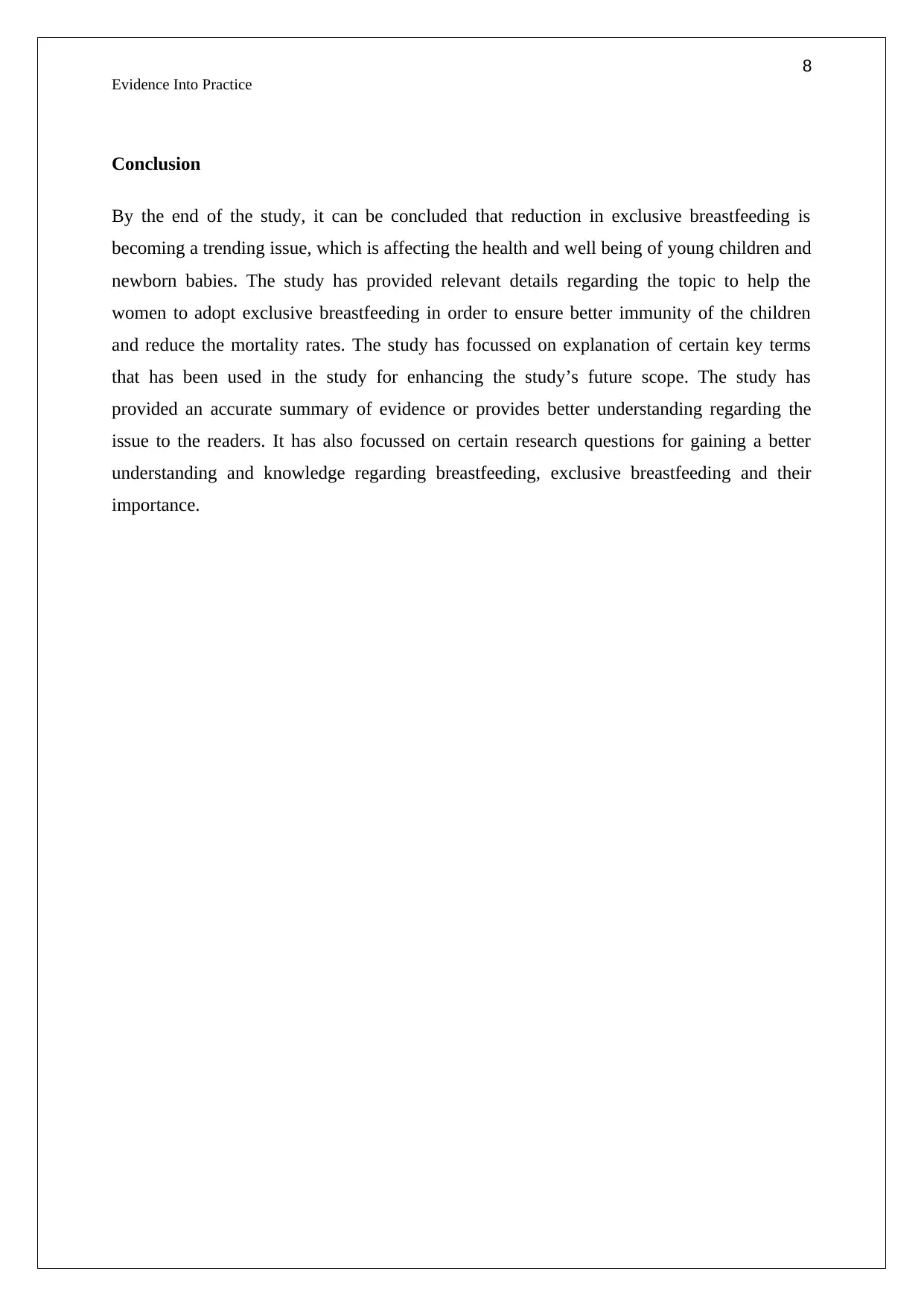
8
Evidence Into Practice
Conclusion
By the end of the study, it can be concluded that reduction in exclusive breastfeeding is
becoming a trending issue, which is affecting the health and well being of young children and
newborn babies. The study has provided relevant details regarding the topic to help the
women to adopt exclusive breastfeeding in order to ensure better immunity of the children
and reduce the mortality rates. The study has focussed on explanation of certain key terms
that has been used in the study for enhancing the study’s future scope. The study has
provided an accurate summary of evidence or provides better understanding regarding the
issue to the readers. It has also focussed on certain research questions for gaining a better
understanding and knowledge regarding breastfeeding, exclusive breastfeeding and their
importance.
Evidence Into Practice
Conclusion
By the end of the study, it can be concluded that reduction in exclusive breastfeeding is
becoming a trending issue, which is affecting the health and well being of young children and
newborn babies. The study has provided relevant details regarding the topic to help the
women to adopt exclusive breastfeeding in order to ensure better immunity of the children
and reduce the mortality rates. The study has focussed on explanation of certain key terms
that has been used in the study for enhancing the study’s future scope. The study has
provided an accurate summary of evidence or provides better understanding regarding the
issue to the readers. It has also focussed on certain research questions for gaining a better
understanding and knowledge regarding breastfeeding, exclusive breastfeeding and their
importance.
⊘ This is a preview!⊘
Do you want full access?
Subscribe today to unlock all pages.

Trusted by 1+ million students worldwide
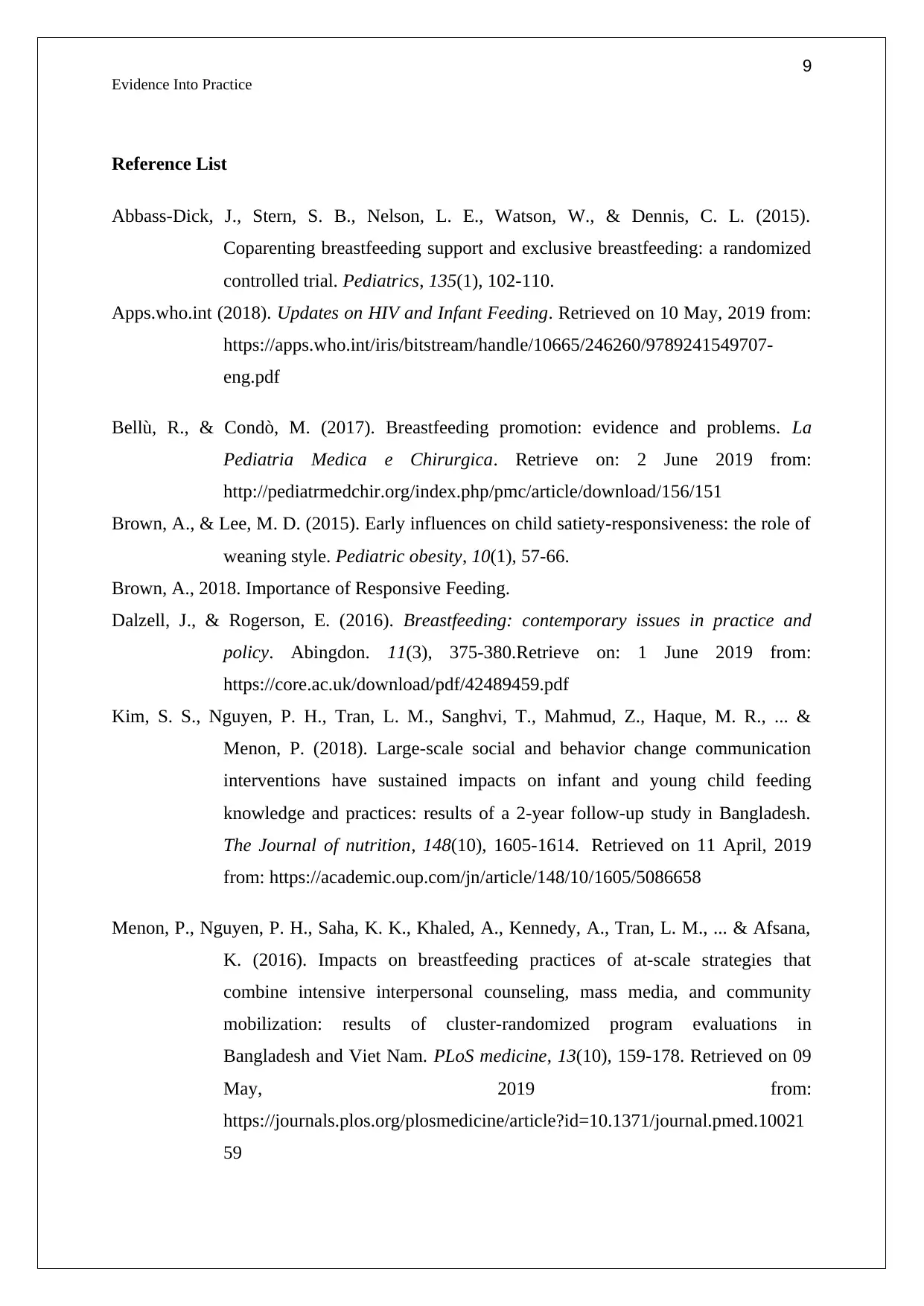
9
Evidence Into Practice
Reference List
Abbass-Dick, J., Stern, S. B., Nelson, L. E., Watson, W., & Dennis, C. L. (2015).
Coparenting breastfeeding support and exclusive breastfeeding: a randomized
controlled trial. Pediatrics, 135(1), 102-110.
Apps.who.int (2018). Updates on HIV and Infant Feeding. Retrieved on 10 May, 2019 from:
https://apps.who.int/iris/bitstream/handle/10665/246260/9789241549707-
eng.pdf
Bellù, R., & Condò, M. (2017). Breastfeeding promotion: evidence and problems. La
Pediatria Medica e Chirurgica. Retrieve on: 2 June 2019 from:
http://pediatrmedchir.org/index.php/pmc/article/download/156/151
Brown, A., & Lee, M. D. (2015). Early influences on child satiety‐responsiveness: the role of
weaning style. Pediatric obesity, 10(1), 57-66.
Brown, A., 2018. Importance of Responsive Feeding.
Dalzell, J., & Rogerson, E. (2016). Breastfeeding: contemporary issues in practice and
policy. Abingdon. 11(3), 375-380.Retrieve on: 1 June 2019 from:
https://core.ac.uk/download/pdf/42489459.pdf
Kim, S. S., Nguyen, P. H., Tran, L. M., Sanghvi, T., Mahmud, Z., Haque, M. R., ... &
Menon, P. (2018). Large-scale social and behavior change communication
interventions have sustained impacts on infant and young child feeding
knowledge and practices: results of a 2-year follow-up study in Bangladesh.
The Journal of nutrition, 148(10), 1605-1614. Retrieved on 11 April, 2019
from: https://academic.oup.com/jn/article/148/10/1605/5086658
Menon, P., Nguyen, P. H., Saha, K. K., Khaled, A., Kennedy, A., Tran, L. M., ... & Afsana,
K. (2016). Impacts on breastfeeding practices of at-scale strategies that
combine intensive interpersonal counseling, mass media, and community
mobilization: results of cluster-randomized program evaluations in
Bangladesh and Viet Nam. PLoS medicine, 13(10), 159-178. Retrieved on 09
May, 2019 from:
https://journals.plos.org/plosmedicine/article?id=10.1371/journal.pmed.10021
59
Evidence Into Practice
Reference List
Abbass-Dick, J., Stern, S. B., Nelson, L. E., Watson, W., & Dennis, C. L. (2015).
Coparenting breastfeeding support and exclusive breastfeeding: a randomized
controlled trial. Pediatrics, 135(1), 102-110.
Apps.who.int (2018). Updates on HIV and Infant Feeding. Retrieved on 10 May, 2019 from:
https://apps.who.int/iris/bitstream/handle/10665/246260/9789241549707-
eng.pdf
Bellù, R., & Condò, M. (2017). Breastfeeding promotion: evidence and problems. La
Pediatria Medica e Chirurgica. Retrieve on: 2 June 2019 from:
http://pediatrmedchir.org/index.php/pmc/article/download/156/151
Brown, A., & Lee, M. D. (2015). Early influences on child satiety‐responsiveness: the role of
weaning style. Pediatric obesity, 10(1), 57-66.
Brown, A., 2018. Importance of Responsive Feeding.
Dalzell, J., & Rogerson, E. (2016). Breastfeeding: contemporary issues in practice and
policy. Abingdon. 11(3), 375-380.Retrieve on: 1 June 2019 from:
https://core.ac.uk/download/pdf/42489459.pdf
Kim, S. S., Nguyen, P. H., Tran, L. M., Sanghvi, T., Mahmud, Z., Haque, M. R., ... &
Menon, P. (2018). Large-scale social and behavior change communication
interventions have sustained impacts on infant and young child feeding
knowledge and practices: results of a 2-year follow-up study in Bangladesh.
The Journal of nutrition, 148(10), 1605-1614. Retrieved on 11 April, 2019
from: https://academic.oup.com/jn/article/148/10/1605/5086658
Menon, P., Nguyen, P. H., Saha, K. K., Khaled, A., Kennedy, A., Tran, L. M., ... & Afsana,
K. (2016). Impacts on breastfeeding practices of at-scale strategies that
combine intensive interpersonal counseling, mass media, and community
mobilization: results of cluster-randomized program evaluations in
Bangladesh and Viet Nam. PLoS medicine, 13(10), 159-178. Retrieved on 09
May, 2019 from:
https://journals.plos.org/plosmedicine/article?id=10.1371/journal.pmed.10021
59
Paraphrase This Document
Need a fresh take? Get an instant paraphrase of this document with our AI Paraphraser
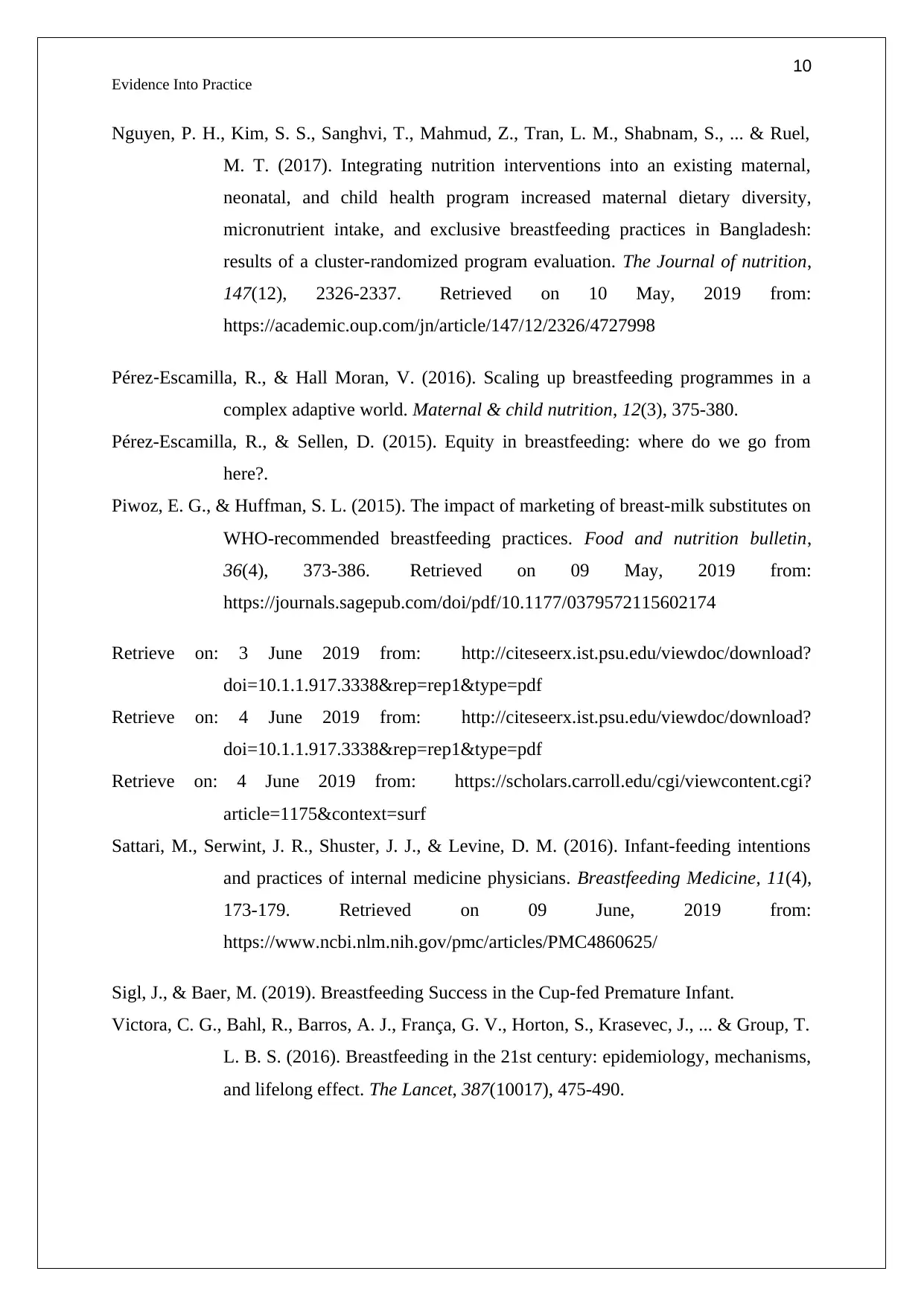
10
Evidence Into Practice
Nguyen, P. H., Kim, S. S., Sanghvi, T., Mahmud, Z., Tran, L. M., Shabnam, S., ... & Ruel,
M. T. (2017). Integrating nutrition interventions into an existing maternal,
neonatal, and child health program increased maternal dietary diversity,
micronutrient intake, and exclusive breastfeeding practices in Bangladesh:
results of a cluster-randomized program evaluation. The Journal of nutrition,
147(12), 2326-2337. Retrieved on 10 May, 2019 from:
https://academic.oup.com/jn/article/147/12/2326/4727998
Pérez‐Escamilla, R., & Hall Moran, V. (2016). Scaling up breastfeeding programmes in a
complex adaptive world. Maternal & child nutrition, 12(3), 375-380.
Pérez-Escamilla, R., & Sellen, D. (2015). Equity in breastfeeding: where do we go from
here?.
Piwoz, E. G., & Huffman, S. L. (2015). The impact of marketing of breast-milk substitutes on
WHO-recommended breastfeeding practices. Food and nutrition bulletin,
36(4), 373-386. Retrieved on 09 May, 2019 from:
https://journals.sagepub.com/doi/pdf/10.1177/0379572115602174
Retrieve on: 3 June 2019 from: http://citeseerx.ist.psu.edu/viewdoc/download?
doi=10.1.1.917.3338&rep=rep1&type=pdf
Retrieve on: 4 June 2019 from: http://citeseerx.ist.psu.edu/viewdoc/download?
doi=10.1.1.917.3338&rep=rep1&type=pdf
Retrieve on: 4 June 2019 from: https://scholars.carroll.edu/cgi/viewcontent.cgi?
article=1175&context=surf
Sattari, M., Serwint, J. R., Shuster, J. J., & Levine, D. M. (2016). Infant-feeding intentions
and practices of internal medicine physicians. Breastfeeding Medicine, 11(4),
173-179. Retrieved on 09 June, 2019 from:
https://www.ncbi.nlm.nih.gov/pmc/articles/PMC4860625/
Sigl, J., & Baer, M. (2019). Breastfeeding Success in the Cup-fed Premature Infant.
Victora, C. G., Bahl, R., Barros, A. J., França, G. V., Horton, S., Krasevec, J., ... & Group, T.
L. B. S. (2016). Breastfeeding in the 21st century: epidemiology, mechanisms,
and lifelong effect. The Lancet, 387(10017), 475-490.
Evidence Into Practice
Nguyen, P. H., Kim, S. S., Sanghvi, T., Mahmud, Z., Tran, L. M., Shabnam, S., ... & Ruel,
M. T. (2017). Integrating nutrition interventions into an existing maternal,
neonatal, and child health program increased maternal dietary diversity,
micronutrient intake, and exclusive breastfeeding practices in Bangladesh:
results of a cluster-randomized program evaluation. The Journal of nutrition,
147(12), 2326-2337. Retrieved on 10 May, 2019 from:
https://academic.oup.com/jn/article/147/12/2326/4727998
Pérez‐Escamilla, R., & Hall Moran, V. (2016). Scaling up breastfeeding programmes in a
complex adaptive world. Maternal & child nutrition, 12(3), 375-380.
Pérez-Escamilla, R., & Sellen, D. (2015). Equity in breastfeeding: where do we go from
here?.
Piwoz, E. G., & Huffman, S. L. (2015). The impact of marketing of breast-milk substitutes on
WHO-recommended breastfeeding practices. Food and nutrition bulletin,
36(4), 373-386. Retrieved on 09 May, 2019 from:
https://journals.sagepub.com/doi/pdf/10.1177/0379572115602174
Retrieve on: 3 June 2019 from: http://citeseerx.ist.psu.edu/viewdoc/download?
doi=10.1.1.917.3338&rep=rep1&type=pdf
Retrieve on: 4 June 2019 from: http://citeseerx.ist.psu.edu/viewdoc/download?
doi=10.1.1.917.3338&rep=rep1&type=pdf
Retrieve on: 4 June 2019 from: https://scholars.carroll.edu/cgi/viewcontent.cgi?
article=1175&context=surf
Sattari, M., Serwint, J. R., Shuster, J. J., & Levine, D. M. (2016). Infant-feeding intentions
and practices of internal medicine physicians. Breastfeeding Medicine, 11(4),
173-179. Retrieved on 09 June, 2019 from:
https://www.ncbi.nlm.nih.gov/pmc/articles/PMC4860625/
Sigl, J., & Baer, M. (2019). Breastfeeding Success in the Cup-fed Premature Infant.
Victora, C. G., Bahl, R., Barros, A. J., França, G. V., Horton, S., Krasevec, J., ... & Group, T.
L. B. S. (2016). Breastfeeding in the 21st century: epidemiology, mechanisms,
and lifelong effect. The Lancet, 387(10017), 475-490.
1 out of 11
Related Documents
Your All-in-One AI-Powered Toolkit for Academic Success.
+13062052269
info@desklib.com
Available 24*7 on WhatsApp / Email
![[object Object]](/_next/static/media/star-bottom.7253800d.svg)
Unlock your academic potential
Copyright © 2020–2025 A2Z Services. All Rights Reserved. Developed and managed by ZUCOL.





